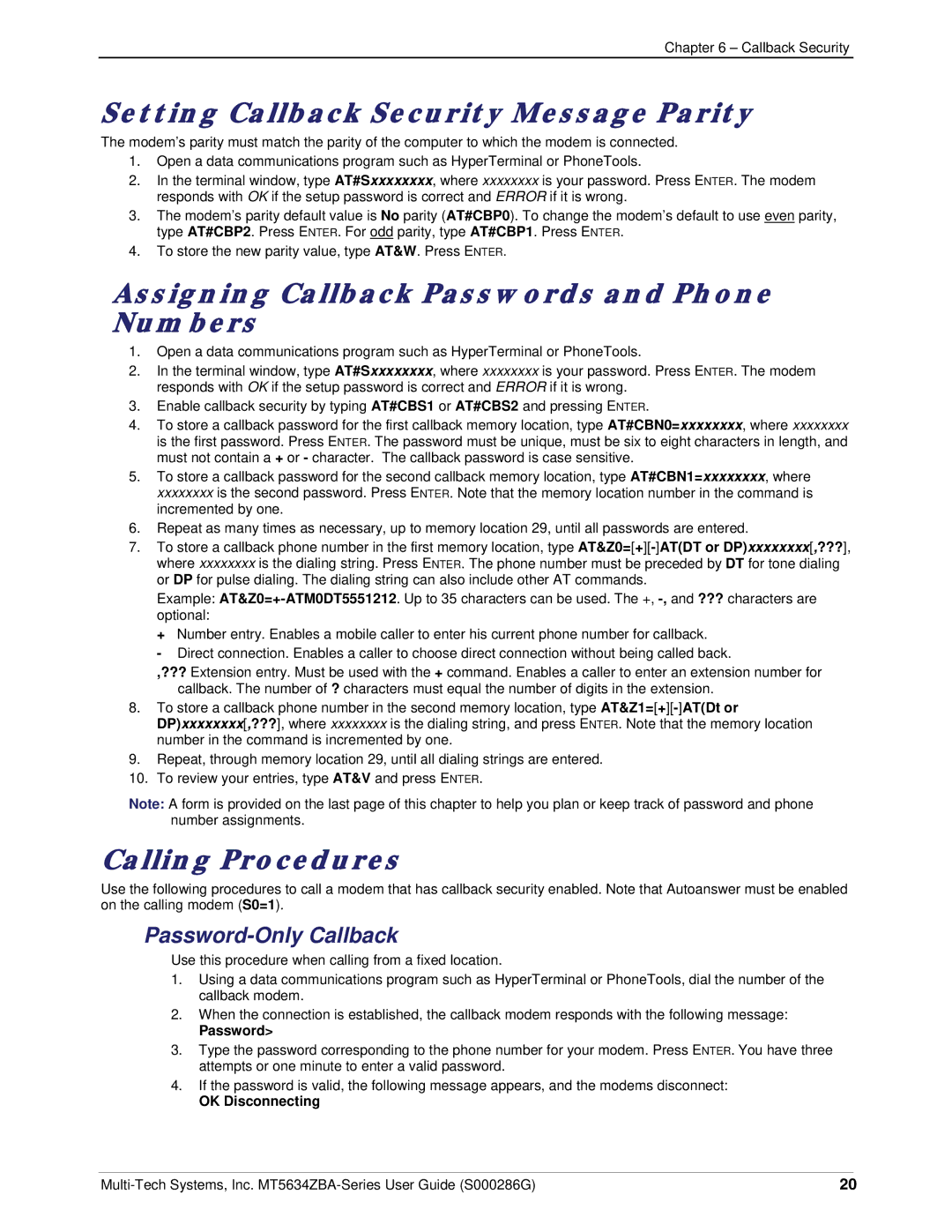
Chapter 6 – Callback Security
Setting Callback Security Message Parity
The modem’s parity must match the parity of the computer to which the modem is connected.
1.Open a data communications program such as HyperTerminal or PhoneTools.
2.In the terminal window, type AT#Sxxxxxxxx, where xxxxxxxx is your password. Press ENTER. The modem responds with OK if the setup password is correct and ERROR if it is wrong.
3.The modem’s parity default value is No parity (AT#CBP0). To change the modem’s default to use even parity, type AT#CBP2. Press ENTER. For odd parity, type AT#CBP1. Press ENTER.
4.To store the new parity value, type AT&W. Press ENTER.
Assigning Callback Passwords and Phone Numbers
1.Open a data communications program such as HyperTerminal or PhoneTools.
2.In the terminal window, type AT#Sxxxxxxxx, where xxxxxxxx is your password. Press ENTER. The modem responds with OK if the setup password is correct and ERROR if it is wrong.
3.Enable callback security by typing AT#CBS1 or AT#CBS2 and pressing ENTER.
4.To store a callback password for the first callback memory location, type AT#CBN0=xxxxxxxx, where xxxxxxxx is the first password. Press ENTER. The password must be unique, must be six to eight characters in length, and must not contain a + or - character. The callback password is case sensitive.
5.To store a callback password for the second callback memory location, type AT#CBN1=xxxxxxxx, where xxxxxxxx is the second password. Press ENTER. Note that the memory location number in the command is incremented by one.
6.Repeat as many times as necessary, up to memory location 29, until all passwords are entered.
7.To store a callback phone number in the first memory location, type
Example:
+ Number entry. Enables a mobile caller to enter his current phone number for callback.
- Direct connection. Enables a caller to choose direct connection without being called back.
,??? Extension entry. Must be used with the + command. Enables a caller to enter an extension number for callback. The number of ? characters must equal the number of digits in the extension.
8.To store a callback phone number in the second memory location, type
DP)xxxxxxxx[,???], where xxxxxxxx is the dialing string, and press ENTER. Note that the memory location number in the command is incremented by one.
9.Repeat, through memory location 29, until all dialing strings are entered.
10.To review your entries, type AT&V and press ENTER.
Note: A form is provided on the last page of this chapter to help you plan or keep track of password and phone number assignments.
Calling Procedures
Use the following procedures to call a modem that has callback security enabled. Note that Autoanswer must be enabled on the calling modem (S0=1).
Password-Only Callback
Use this procedure when calling from a fixed location.
1.Using a data communications program such as HyperTerminal or PhoneTools, dial the number of the callback modem.
2.When the connection is established, the callback modem responds with the following message:
Password>
3.Type the password corresponding to the phone number for your modem. Press ENTER. You have three attempts or one minute to enter a valid password.
4.If the password is valid, the following message appears, and the modems disconnect:
OK Disconnecting
20 |
